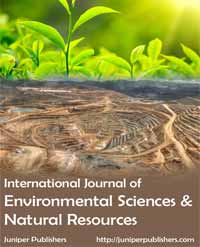Concept of Population Ecology - Juniper Publishers
Juniper Publishers-Open Access Journal of Environmental Sciences & Natural Resources
Concept of Population Ecology
Authored by Nida Tabassum Khan
Introduction
Population ecology deals with the study of the structure and subtleties of a population which comprises of a group of interacting organisms of the same specie that occupies a given area [1]. Populations can be characterized as local which is a group of less number of individuals occupying a small area or met which is a group of local populations linked by disbanding members [2]. The demographic structure of a population is a key factor which is characterized by the number of individual members (population size) present at each developmental stage of their cycle to identify whether the population of a specific specie is growing, shrinking or remain constant in terms of its size [3]. Densely packed population of individuals is called population density [4]. Local population of species consists of distinctive gene collection therefore species are genetically different from one another manifesting distinct phenotypic characteristic [5]. The gene pool (total cumulative genes in a population at a certain time) of an organism is affected as those phenotypes that are compatible with the environment are selected by nature and is inherited by the next progeny [6]. The extent of genetic variation depends on population size and reproduction mode as small isolated asexual species have little variation as compared to large sexual populations [7]. In sexual species recombination of genes occurs as a result half of the genes are inherited from the father and the remaining half from the mother which produces a different genotype from either parent or any other individual in the population [8]. In sexually reproducing species, favorable mutations initially appears in separate members which then recombined in many ways over time but such recombination is not seen in asexual population [9]. A trait can be easily lost from a small population by means of random genetic drift therefore variation is easily sustained in large populations than in smaller ones [10]. Natural selection selects the most favorable phenotypes suited for an organism survival thereby reducing variation within populations [11]. Population structure determines the arrays of demographic variation such as mode of reproduction, age, reproduction frequency, offspring counts, gender ratio of newborns etc within/among populations [12]. These distinct characteristics affect the reproductive capabilities of population as well as their dynamics and progression [13]. Progression of a population could be well understood by considering the age parameter during first reproduction [14]. Natural selection favors population that reproduces earlier thereby introducing their genes in to the gene pool and thus occupying a dominant position in the realm However not all the individuals of a given population is subjected to early maturation for reproduction [15]. Because it is essential that individuals within a population should devote their resources to fulfill their physiological demands to become healthy and fit for survival then to reproduce for the progression of their generation .This is termed as the cost of reproduction [16]. In many inhabitants, individuals that delay reproduction have a better chance of surviving and leaving offspring than those that attempt to reproduce early [17].
Populations is often divided into two types based on their life history strategy. Some populations give birth at an early age producing many offspring at once because of extreme and uncertain environment [18]. Another type of population reproduces few individuals that the environment can sustain giving birth at a later age to fewer off spring in more stable environments [19]. These reproduction strategies of different populations can be presented by means of life tables to find out its affect onpopulation dynamics as it is clear that individuals which reproduces at an early age have the potential to grow much faster than populations in which individuals reproduce later [20]. Life tables not only predicts the life expectancies of nonhuman populations, as well as the effects of variation on demography and population growth evaluating how it influences the overall growth rate of a population [21]. Life table for a population displays the fate of allthe individuals born at the same time in a population indicating the number and life span of individuals [22]. Plotting the number of those individuals that are alive at each age results in a survivorship curve for the population [23].
Three Types of Survivorship Curve
Traditionallyaerial parts of the plant are used but some time roots are also used in various ailments. B.lupulina has also been reported to possess a potent anti-inflammatory [3], anti malarial, anti-cancer [4], analgesic [5], anti-leukemic, antitumor, anti-hyperglycemic, anti-amoebic, virucidal [6], diuretic [7], bactericidal [8], insecticidal, immunomodulatory, antioxidative and antibiotic properties [9]. It has also been traditionally used for diabetes, rheumatoid arthritis, eczema, itches, scabies, and snake bite, antiviral activity against HSV-2 and anti-ulcer, cough, fever, anti-alergic for skin, etc.
a) Type I Survivorship Curve: Largespecies such reproduces fewer numbers of offspring and devote much time and energy in caring for their young [24].
b) Type II Survivorship Curve: Species that produce many offspring but provide little care for them [25]
c) Type III Survivorship Curve: This life history is initially very steep, which is reflective of very high mortality among the young, but flattens out as those individuals who reach maturity survive for a relatively longer time [26]
However many populations have complex survivorship curves e.g. passerine birds (commonly suffer high mortality during the first year of life and a lower, more constant rate of death in subsequent years [27].
Conclusion
The major issue in population ecology is to derive population characteristics from characteristics of individuals and to derive population processes from the processes in individual organism. Thus to collect all of the information for a population it would likely take a great deal of time, which means more effort and money.
To know more about Juniper Publishers please click on: https://juniperpublishers.com/manuscript-guidelines.php
For more articles in Open Access Journal of Environmental Sciences & Natural Resources please click on: https://juniperpublishers.com/ijesnr/index.php




Comments
Post a Comment